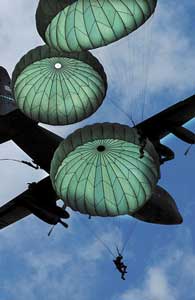 War in Korea
War in Korea
It’s been six decades since hostilities ended on the Korean peninsula. The threat of a resurgence has never been greater than now, and some Fort Bragg soldiers would be among the first thrust into combat.
The military has taken a back seat to the State Department as U.S. officials push diplomatic and economic measures hoping that, with the help of China, the North Korean regime of Kim Jong Un can be persuaded to stop its provocations.
If diplomatic efforts fail and a conventional war ensued, experts agree the scenario would involve massive amounts of U.S. and South Korean forces in a war that could drag on for many months or longer. At a recent press conference, when asked by reporters about the current tensions with North Korea, Secretary of Defense Jim Mattis said, “If this goes to a military solution, it’s going to be tragic on an unbelievable scale.”
Military Times has constructed a detailed overview of what war on the Korean Peninsula would be like, based on interviews with current and former military officials as well as intelligence assessments of North Korea’s military capabilities.
In the opening hours, U.S. officials would alert Marines on Okinawa to begin heading toward the fight. Back in the United States the call would go out to the Army’s 82nd Airborne Division to launch its brigade combat team of paratroopers.
A battalion of America’s Global Response Force is poised to deploy within 18 hours. The balance of the assigned 82nd brigade combat team would be “wheels up” within 96 hours. Experts predict heavy initial casualties among U.S. and South Korean forces.
“Anybody that assumes this could be knocked out in 30 days would be dead wrong,” said retired Army Lt. Gen. Mark Hertling. “There would be literally thousands, tens of thousands, some say more than 100,000 civilian casualties.”
Rural Fire Department Revenue Deficits
This year’s downturn in Cumberland County property values has had a significant impact on rural fire departments. Municipal fire departments are supported through ad valorem property taxes, which can be adjusted as needed.
Volunteer departments are sustained by local fire district taxes also based on property values. Property owners in the county pay a fire tax of 10 cents per hundred dollars of valuation over and above regular property taxes. In the fiscal year ahead, the fire tax levy will not yield as much revenue as in the past. Twelve of the county’s rural fire departments will come up $265,000 short in lost revenue. The loss will severely impact rural-most departments which operate on small budgets.
Larger ones, like Pearces Mill Fire Department south of Fayetteville, would lose as much as $44,000 in fiscal year 2018, according to Fire Chief’s Association President Freddie Johnson. “We can tighten our belt and get by,” said longtime Pearces Mill Fire Chief Ronnie Marley. “But the long-term solution is not as hopeful.”
County Manager Amy Cannon is proposing to dip into the association’s surplus to provide each rural department at least one-half of their revenue shortfalls. “In the long term, there needs to be a very thorough review of fire department funding,” said Cannon.
Downtown Fayetteville Field of Honor
Fayetteville’s Airborne & Special Operations Museum is again honoring service members, veterans and their families with Field of Honor American flags on the parade ground between the museum and the North Carolina Veterans Park downtown. The annual tribute, sponsored by the Fayetteville Downtown Alliance, features hundreds of American flags, which can be purchased and dedicated to honor special people in the lives of those making the purchases. Arrangements can be made at the museum’s gift shop. “The flags will be flown through the end of this month,” said Paul Galloway, President of the Museum Foundation.
Downtown Parking May Change
It may not be long before parking meters return to Hay Street downtown. City Council wants to encourage people to park in the four-story parking garage on Franklin Street. That’s one idea the city is considering to make up for the loss of dozens of spaces in the center of the city when the minor league baseball stadium is built.
Another idea is a second, but smaller, parking deck — this one behind City Hall. City Manager Doug Hewett revealed that suggestion in his proposed FY18 city budget. Some members of City Council note the underutilized parking garage on Franklin Street is two blocks from City Hall and could easily be utilized by city employees. “There is a serious parking problem that is going to get worse,” Councilman Bill Crisp said. Many of the parking spots being lost to progress are near the Amtrak railroad station where City Hall employees normally park.
Fayetteville Physician named to Public Health Commission
Dr. J. Wayne Riggins of Fayetteville has been appointed by Governor Roy Cooper to the North Carolina Commission for Public Health. The commission consists of 13 members, four of whom are elected by the North Carolina Medical Society and nine who are appointed
by the Governor.
Dr. Riggins is a practicing ophthalmologist. He graduated from F. Edward Hebert School of Medicine at the Uniformed Services University of Health Sciences in 1993. He completed his residency at Walter Reed National Military Medical Center and currently practices at Cape Fear Eye Associates. Riggins is affiliated with Cape Fear Valley Medical Center and Highsmith-Rainey Specialty Hospital.